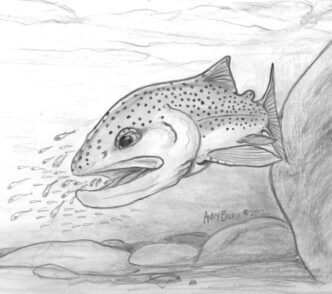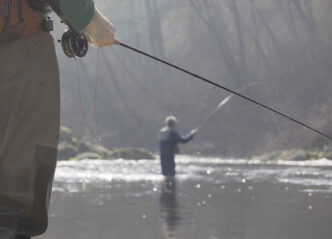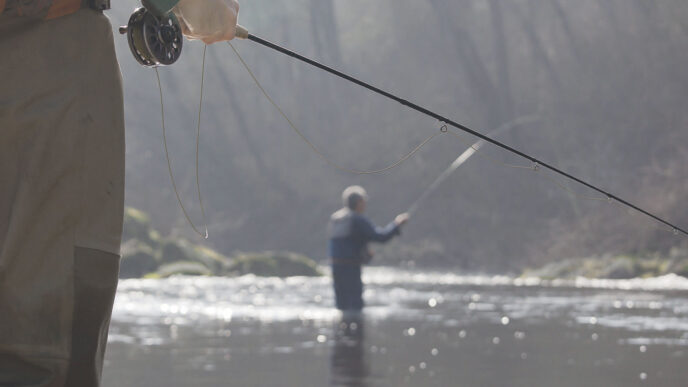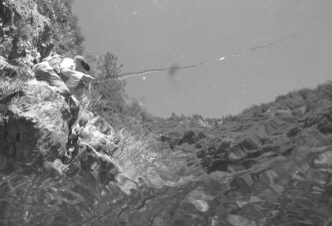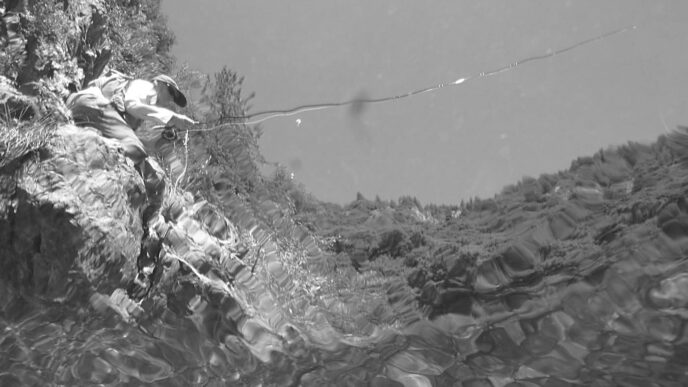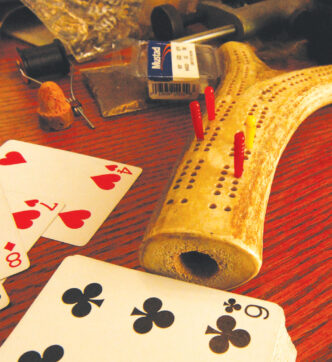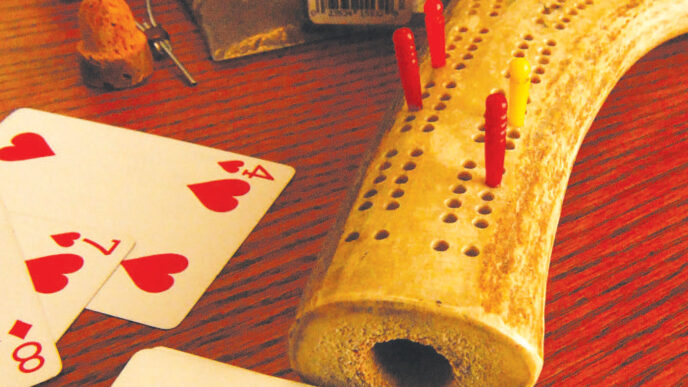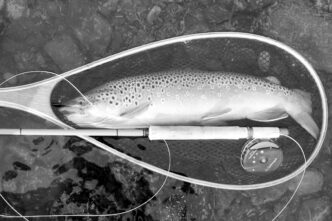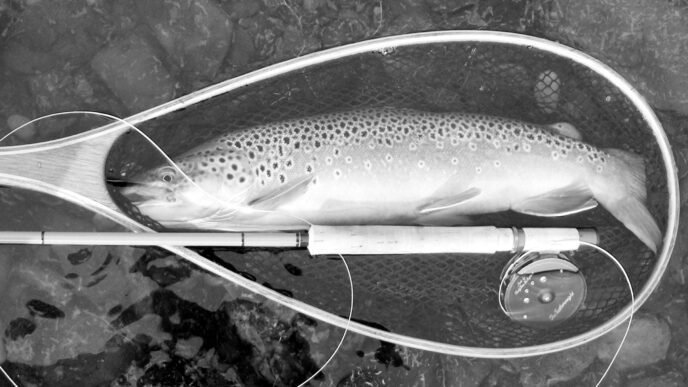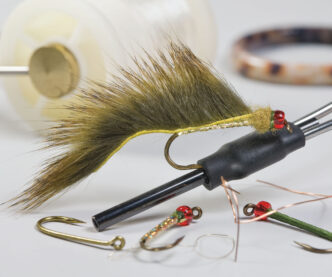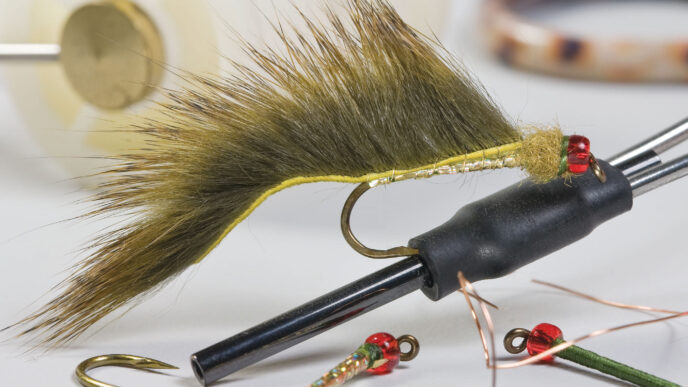It started out as a simple trip to a small but pretty trout water nestled in a canyon in the Angeles National Forest about an hour away from the house. The weather was beautiful — sunny and warm, with light breezes and the promise of stable weather all weekend. That alone, though, should have given me pause.
When I reached the stream, I discovered many others had also taken note of just how fine a day it was. There was hardly a place to park, and every pool had at least half a dozen kids cavorting in it. The very though of fishing here was obviously absurd.
Giving up on the stream. I drove aimlessly back toward the community of Wrightwood, intending to have a late second breakfast there. My route took me higher into the Angeles forest, and soon I drove by Jackson Lake, a small roadside pond that gets most of its attention from the folks who follow the fish-stocking trucks. Apparently they hadn’t stocked that week, because there were only a couple of cars in the small parking area.
I slowed a bit as I passed the pond and was just about to speed up when I saw a ring form on the placid surface, just off the steep shore along the roadside of the pond. I didn’t know if it was a trout, but it was definitely a rising fish. That was enough for me. I turned around and went back to the parking lot.
I was mostly set up for stream angling, with a short 3-weight for the tight confines of the creek I had intended to fish, but under the seat of my truck was a rod case with a longer rod and a reel spooled with a 6-weight line. It took only a couple of minutes to assemble my gear and walk as close as I could get to where I had seen the riseform. While I was approaching, the fish rose again, and I got a look at it. No bluegill this — it definitely was a trout. The rise was one of those splashy things that lets you know the fish was chasing something. There were a few damselflies buzzing around, so I tied on an adult damselfly pattern that I had left in the truck after an outing to the Sierra some weeks previously.
When that fly produced nothing, I switched to the closest thing I had to a damselfly nymph — an olive Woolly Bugger, size 12. The fish exhibited that splashy rise again and was joined by a second fish that seemed to be chasing the same food items. Two casts later, I had a sharp tap on the Bugger, and on the next cast, the fish took the fly solidly.
I managed to keep the fish out of the dense stand of tules and soon had in hand a respectable trout. It was a rainbow, the only species that inhabits Jackson Lake. If you pulled hard on its nose and tail, it would have just covered 12 inches, almost certainly a fish held over from a prior stocking. I released it and two casts later connected again with a trout that could have been a clone of the first.
The fishing that morning never got to the “fish every cast” state, but by the time it was warm enough to shed my jacket and long-sleeved shirt and start thinking seriously about coffee and a chance to sit down, I had caught and released half a dozen trout and had missed several more. By late morning, I had caught another half a dozen. The two bait anglers down the shore had also caught a few fish. All in all, it wasn’t a bad morning.
The Nature of Backup Waters
There are many small fisheries like this scattered around Southern California, as well as elsewhere in the state. They’re not spots that a fly fisher would consider primary destinations — rather, they’re the “B Team” (if indeed that), places to visit when expectations elsewhere don’t pan out. If they hold trout, the fish are usually planted, but they may offer opportunities to throw flies for respectable-sized bass and panfish. And sometimes the angling can be surprisingly good.
You can find small waters like these by examining maps and by exploring Web sites, such as those for national forests or those that cater to conventional tackle lure-and-bait anglers. You won’t locate the equivalent of Hot Creek, but you might find an out-of-the-way still water or two, and perhaps even a stream, where you can fish when the going gets tough — and that’s most weekends in Southern California, when more than 10 million people spread out to recreate.
Jackson Lake is a near-perfect example of the kind of water I am talking about. At just seven surface acres, it almost precisely matches John Gierach’s description of what constitutes a pond in Standing in a River Waving a Stick: “A small body of still water of artificial formation.”
The impoundment is located west of the mountain town of Wrightwood at the far eastern end of the Angeles National Forest. To reach it from almost anywhere in the Los Angeles Basin or the Inland Empire, follow Interstate 15 to Cajon Pass, then Highway 138 up to Highway 2, which brings you to and through Wrightwood. Then take County Road N4. Jackson Lake lies right by the paved road and is impossible to miss.
There’s a spacious parking lot at the lake, and several small campgrounds are scattered nearby. An old fishing report I found tells me it holds bluegills as well as the trout that are stocked on a regular basis, spring through fall.
A caveat: Don’t expect real solitude on waters such as Jackson Lake. They are known to plenty of local anglers, and you usually have to share the water. It will be less crowded on weekdays rather than on weekends, which is true of every fishing spot in Southern California. A weekday with marginal weather is often a perfect time to visit and fish. I have fished Jackson Lake in perfect solitude, but such an experience is rare.
It’s possible to reach most of the fishable water of this pond while standing on the dry shore. You can wade Jackson Lake in places, and float tubes or pontoons are allowed. I’ve even seen motorized boats on it a time or two.
Little Rock Reservoir
Another backup fishery is Little Rock Reservoir on Little Rock Creek, located like Jackson Lake on the northern side of the Angeles National Forest. Little Rock Creek used to be a very good trout fishery, but the stream above the reservoir is now closed to all entry to protect the arroyo toad, an endangered amphibian native to Southern California.
The reservoir has a capacity of 150 surface acres, but it is seldom completely full. Be skeptical of the information about it that you find on the Internet. A phone call to the reservoir’s store will contradict the boating regulations shown on Web sites. Boats are available for rent, but no private boats are allowed — just the opposite of what is currently stated on the lake’s Web site. Float tubes are not allowed, either. On the other hand, shore access to this small reservoir is good, with almost the entire shore open to prospecting for trout and other species.
Lost Lake and Lake Fulmor
One of the oddest waters I would place in the backup group is Lost Lake. This pond, only a few acres in size, lies just west of Interstate 15 at Cajon Pass. Created by the San Andreas Fault, which runs right through Lone Pine Canyon, it presently is not on any agency’s stocking list. The last time I was there, it still held some decent-sized bluegills and bass that a lucky angler might catch.
This little pond is on San Bernardino National Forest land, and while it has parking at a couple of restrooms of the portable variety, there is little else to recommend it to the wandering angler. Local teenagers and others visit here to party, so I make it a practice to leave the pond before night falls. That said, in the middle of the week, it is often deserted and just fine as a spot to while away a couple of hours.

Another tiny roadside pond (or puddle) is located high up on Mount San Jacinto. If you take State Highway 243 out of Banning and head into this detached portion of the San Bernardino National Forest, you will find Lake Fulmor at the 5,300-foot elevation. It is just three surface acres in size, and the highway forms part of the dam that creates this narrow little impoundment.
Well known by local anglers, it often gets a lot of nonfishing pressure on weekends, but the Department of Fish and Game stocks it when conditions are suitable. I used to take my boys there to fish on our way to Lake Hemet. Over the years when they were learning how to use fly rods, we caught a lot of stocked trout at Fulmor. If not for the brush and trees around the lake, you could cast across it at most points.
Lake Gregory
An impoundment near Lake Fulmor that also qualifies in my mind as a backup fishery, rather than as a serious destination, is Lake Gregory. This is a much larger body of water at 120 surface acres, and it is situated smack in the middle of the mountain community of Crestline, a busy spot any time of the week. However, before the recession hit, I could visit Lake Gregory on a weekday and find only a dozen or so bait-and-lure anglers scattered around this fair-sized body of water. These days, you may see more.
Lake Gregory is part of a San Bernardino County park, and because of its altitude (4,500 feet), it ices over at times during winter. What makes this still water an interesting backup to larger lakes, such as Silverwood and Big Bear, is that it gets most of its trout stocked during the spring and summer months, well after Southern California lakes at lower altitude switch to stocking catfish for the bait anglers. It is also big enough to have fair numbers of holdover fish that have become completely wild by their second year.
I’ve prowled the shoreline of Gregory casting flies for hatchery trout during the cooler times of the year or throwing bass bugs for the warmwater species that live in the lake. These include bluegills, bass, and hordes of small crappies. Gregory is also a lake where you are allowed to launch a float tube.
A float-tube makes fishing Gregory pretty simple. The impoundment is a good fallback destination when the winds are howling on Silverwood Lake to the north. Often the slight change in altitude is enough to change the weather completely. Other than size, the main difference between Jackson and Fulmor lakes and Lake Gregory is that an angling and tube launch fee are charged at Gregory. The other two have open access.
To reach Lake Gregory, take the 210 freeway east to Waterman Avenue in San Bernardino. Take Waterman Avenue north (it becomes Highway 18 heading into the mountains) to Lake Gregory and Crestline.
Jenks Lake
Located just off Highway 38 (one of the “back” roads to Big Bear Lake) in the Barton Flats area, Jenks Lake sits at an altitude of 6,700 feet, so it ices over in the winter and is closed from mid-November until mid-March. It receives routine stocks of trout from the DFG during the spring, summer, and fall, and it also has bluegills and bass to supplement the trout angling. These last, of course, are wild fish.
At five surface acres, Jenks qualifies as a largish pond. Float tubes and kayaks are allowed when the lake is officially open, and this can be a pretty nice mountain destination. Lots of anglers know about Jenks, so weekdays offer your best shot at reasonable solitude. The days before school lets out in the spring and after school resumes in the fall until the Forest Service closes the lake are your best bet.
I was going to include a nifty little mountain pond in San Diego County in this report, but I learned from the Internet that it is closed due to the budget problems that all California governments now face. Tiny Doane Pond is up on Palomar Mountain, at a campground that gets lots of sightseers and tourists, but few fly fishers. Doane is just three acres and is quite shallow, making it a better panfish pond than a trout lake, but when it was open, it received stocks of DFG trout and was another good spot to while away an afternoon when everything else was crowded out by hordes of bait anglers. Urban fly anglers need a few spots to keep in mind as fallback positions when waters get crowded during summer, and finding places like those I’ve discussed here can get you used to the idea that some decent fishing can be experienced in odd or out-of-the-way spots all around the Southland. Chances are, with a little snooping, you can come up with your own personalized list of backup waters.






